Last updated on November 19th, 2023
Featured image: Is it possible to walk the Camino de Santiago without a phone? Author Jules Torti finds out! | Photo by Jules Torti
The adventures of walking the Camino phone-less
by Jules Torti
“We’re traveling without a phone.” The response was consistently panicked. “Oh my god, was it stolen?” “Oh no, did you lose it?” “But, how are you taking pictures?” (*To clarify, we had a Canon camera with us).
These past three weeks, my wife Kim and I were in Portugal and Spain, walking a 320 km leg of the Camino Portuguese coastal route from Porto to Santiago before flopping supine on Falesia beach in the Algarve for a week. In 2018, we walked 920 km on the Camino de Santiago from Saint-Jean-Pied-de-Port, France to Finisterre, Spain. We did this without a phone too. It never occurred to us that a phone would be necessary–the very nature of the Camino is to find your way by intuition (and sometimes, arrows) NOT by GPS.
We have always opted to leave our phone at home. Yes, that’s right–phone. Not even plural. We share one and I’m not even that involved with it as I only call my parents, two siblings and two friends if we are on the highway for a few hours (and I’m in the mood). There’s no cell reception here at our house on the Northern Bruce Peninsula. Sometimes, if a crow flies over just so and we rub two pine cones together, we find a fragment of a signal halfway down our driveway. There’s usually enough of a connection to wait out a caller queue and answer a security question before the call is dropped. Wishing family members a happy new year is always in blizzard conditions with a hot water bottle stuffed under my puffa jacket in the cloak of our designated Dark Sky Preserve darkness.
So, I’m not that attached to a phone in general or texting anyone, ever, unless Kim is driving. When I’m working, social media is a non-negotiable part of my job description at Wild Women Expeditions. I’m a writer and naturally, I’m expected to write about the experience as it’s unfolding–not upon returning home.
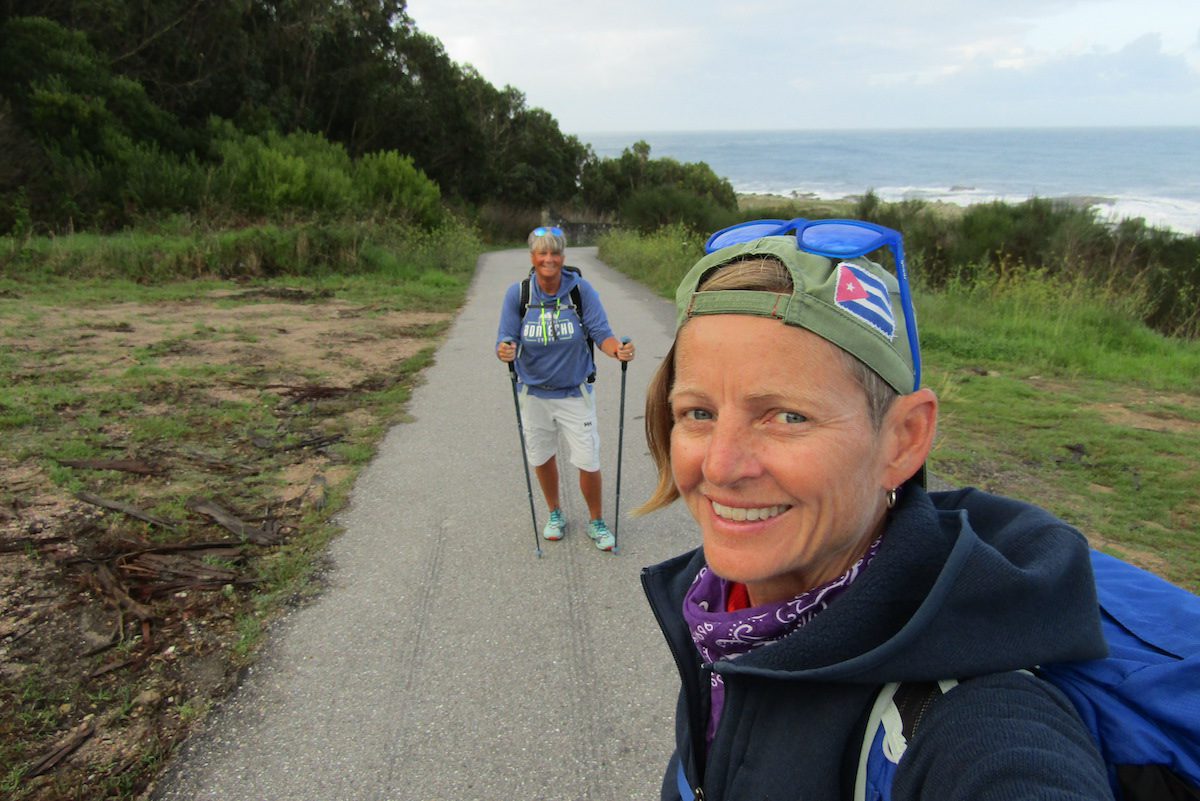
Jules and her wife Kim making headway and about to turn inland with the Atlantic on their shoulder / Photo by Jules Torti
Reservations of a Different Sort
I’m beginning to turn into my great-grandmother, I know. I walked five miles in the snow, up to my waist, to the one-room schoolhouse. Is it so antiquated to still want a phone that stays at home like the landline years? Actual books? Glossy magazines and inky newspapers (not digital)? Face-to-face conversations not Facetime? Though it’s daunting and exhausting, I want to keep trying. After being turned away from a dozen hotels without vacancy in Santiago because we didn’t have reservations, Kim is less inclined to continue on this phone-less pilgrimage. She has reservations of a different sort now.
Once upon a time (2018), in a faraway land (Spain), you could walk under the stars until the sun lifted. You would stop for a milky coffee and savoury tortilla at whatever little shop magically (and gratefully) appeared on your path. You could walk into an albergue confident that if it met your specs you could receive a bunk and probably a pilgrim’s meal of spag bol, pork loin, baguette, coffee and a pastry AND half a carafe of wine for 15 euros. These accommodations were only available to pilgrims on a first come, first served basis–no reservations were permitted and those on foot took priority over those who arrived by bike.
Along the Camino Portuguese, dozens of albergues have now adopted a hostel designation as well–which means anyone can book a room in advance. You don’t have to be walking or biking the Camino. The municipal sites (donation-only accommodations that don’t allow reservations) weren’t found in every village on the coastal route. The competition to find a place to stay on the coastal route has become fierce with so many bikers, weekenders and beach tourists pushing the shoulder season up to the neck.
Frayed Nerves and Fretting
Our romantic and nostalgic recollection of those carefree, boho 35 days on the Camino Frances are definitely historical archives ready for a museum shelf. We’re feeling totally defeated by technology after the Camino Portuguese. Kim’s nerves were as frayed as my favourite pair of jeans. It’s next to impossible to travel without a phone anymore because the Camino has shifted. Pilgrims are pre-booking their stays and reserving bunk beds in advance.
While Kim and I were already accustomed to the Camino routine of starting with the stars at 6am, those with secure accommodations had the luxury of lingering in bed, enjoying second cups of lazy coffee conversation and stopping for extended lunches. On the flip side, Kim and I were hustling it, covering 25 to 30 km, chugging lattes and wolfing back leftover crackers to get to our next destination to begin foraging for a hostel or albergue.
We left Ontario with just two pre and post-trip reservations in Porto and the Algarve. In between, we were unworried about finding somewhere to sleep on the Camino route. We never had an issue on the Camino Frances–there were always, always beds.
Regardless if you have a phone or not, there are still logistics and timeframes when a trip involves true legwork. We had to be in Santiago by October 1st as we had flights to Faro on the 2nd. Is there less stress in walking without a pre-booked flight? Probably. Especially when RyanAir cancels one leg of a connecting flight and you have no idea how you’re going to get to the Algarve or Valencia (the second, shorter flight was still operating) after walking the Camino where a prepaid villa and car rental were waiting.
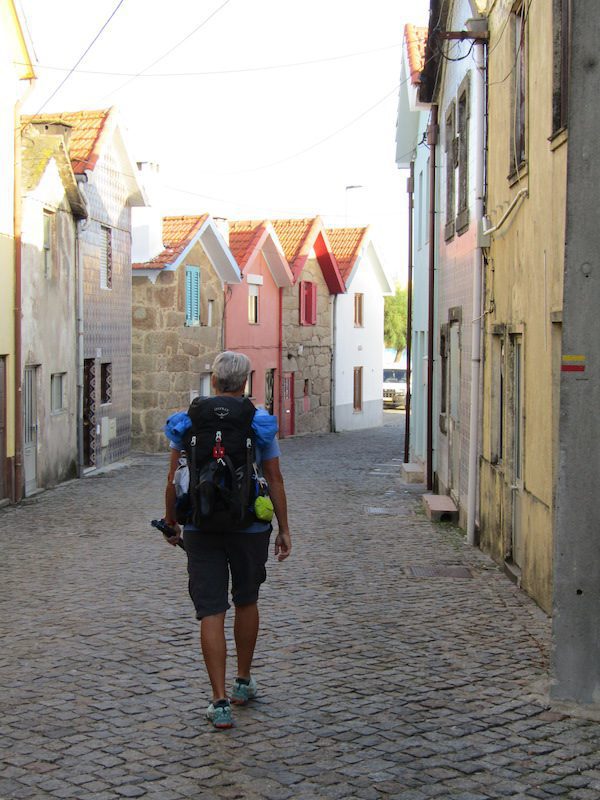
Kim walks through the fishing village of Vila Chã, Portugal / Photo by Jules Torti
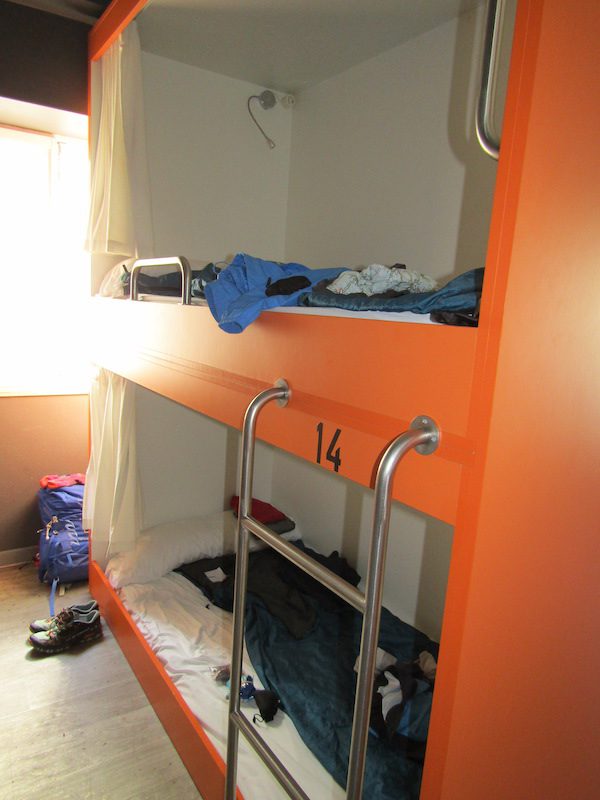
Bunk bed crash pad at A Parada do Camiño, Spain / Photo by Jules Torti
Disconnected from Reality
If we had a phone with us, the solutions may have come faster. Instead, there was a lot of fretting over what should have been celebratory riverside port tastings in Vila Nova de Gaia. The usual “we’ve arrived” thrill was diminished by the uncertainty of, well, everything.
Worst case, we knew we could rent a car from Santiago and drive 8+ hours to Faro but it would be a steep price tag as the mileage (of course) wouldn’t be unlimited and one-way rentals are never, ever reasonable. Before leaving home we were able to confirm that there were no flights to Faro from Santiago–either service had stopped on September 30th for the season or there were simply no seats left on carriers like EasyJet or Iberian Airlines. Even if we hoofed it faster and stacked our mileage on the Camino, leaving for the Algarve two days earlier didn’t help matters. I wasn’t game for a 12-hour milk run bus ride, this I knew for certain. Not to be a princess–but, I knew that much time on a weaving bus would have my stomach equally weaving and heaving.
Without a phone we found ourselves talking to dozens of people in our attempt to figure out the last chunk of what was supposed to be an all-around stress-free, relaxing trip. The only fleeting, minor relief was that we hadn’t decided to go to Tangier post-trip. How the hell would we get there if our flight was cancelled? A boat across the Strait of Gibraltar, eventually, I suppose. At least there were trains in and out of Santiago and though it would take almost as long as the bus with layovers and transfers, we snapped up the train tickets out of desperation, exhaling (slightly) that we had our post-Camino transport mostly sorted (though we still had to get from the Faro train station to the airport to pick up our rental car–and now had to contact the rental agency to change our pick-up time. Somehow.)
Kim and I figured things out, as we always have. Kindness came in the form of so many locals who were impressed but perplexed by our phone-free ways. There’s such irony. While the notion of travelling without a phone, tablet or laptop is freeing to some, it’s become increasingly frustrating since the pandemic. The ArriveCAN app, passenger locator forms, QR codes for vaccinations, PCR test results—maps, menus–and Airbnb door codes, all require a phone. On this trip, we had to beg our Porto Airbnb host for the entry code in advance. “But I will text it the day of, no problem.”
“YES, problem. We will not have our phone with us.”
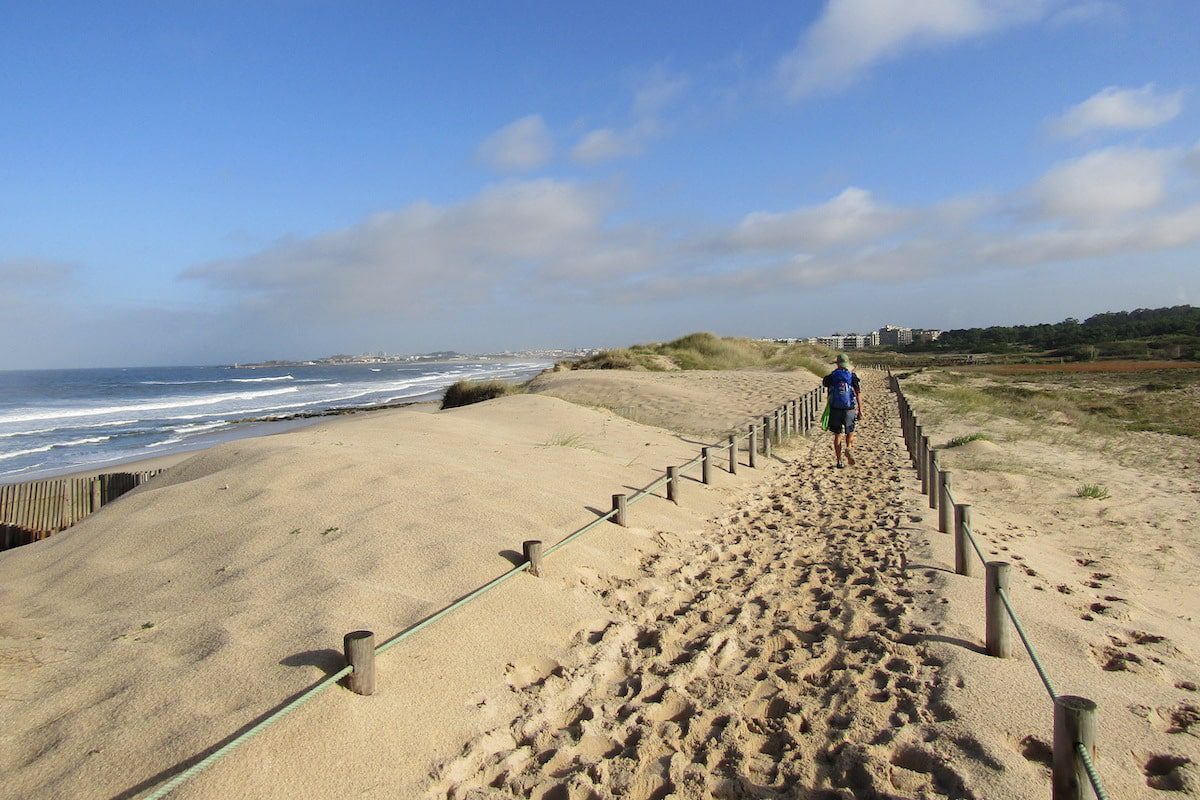
The “boardwalk” on the Camino Portuguese–it needs a bit of a sweep! En route to Vila do Conde, Portugal / Photo by Jules Torti
Recalibrating
I know, as I type this, it’s annoying, even to me. Why are we so resistant? Life could be so much easier, I know. I’m in my TikTok, Snapchat, Instagram, and Whatsapp prime at 49. I’m not looking for sympathy or a trophy but my stubborn Virgo self is trying to hold strong to a life of my own design. One that doesn’t rely on a phone.
We found it so disheartening to see pilgrims walking with their phones in hand, listening to GPS directions ON the Camino. Yes, Kim and I would have loved to have that security blanket hand-hold as we found ourselves incredibly lost in Vigo. Going into the city–and getting out. (The city refuses to allow any traditional Camino markers like the scallop shell on the sidewalk or yellow arrows painted on walls–they have agreed to stickers in storefront windows which are impossible to find at 6am.)
Not to sound all uppity and purist, but this didn’t happen on the Camino Frances five years ago. No one was relying on their phone to navigate–it was all about gut instinct when waymarkers or arrows failed to appear. There were predictable U-turns and countless choppy conversations with locals tending to their cows or vineyards. They were chronically helpful with an exaggerated point and cheerleading grin in the right direction.
The Whims of the Way
Arriving in Santiago this time, we nursed pints of beer and watched pilgrims filter in from the Portuguese route. We were hopeful that we’d see Bonnie from the UK or Sara from Germany or “Poncho” who we’d met on day one, struggling with her poncho in the wicked Atlantic wind tunnel. If we had a phone, we’d know exactly where they were and could have arranged for beers with them. Instead, relying on our Camino Frances memories of whimsy and serendipity, we knew we’d cross paths with those we were meant to. That is (was) the way. We walked for 33 days in the company of Gudrun from Denmark but failed to see her on the very last monumental day in Santiago. There was no reason to exchange emails or phone numbers as we saw each other every single day–at some point. We revelled in the animated antics of five Brits for two afternoons and then didn’t see them again. Same with the gals from South Africa. And yet, the South Korean girls kept appearing, despite their lingering cafe con leche and croissant stops between bus rides.
A Danish woman waved to us –we hadn’t talked to her until Santiago but her face was familiar. She pulled up a seat to watch the people parade and couldn’t believe that we had walked the Portuguese route without a phone. “But, how did you find where to stay?” It was a daily obstacle but like door-to-door salespersons of the past, we knocked and walked and had some flashes of luck. She showed us her phone screen and the app for her daughter’s elementary school. “See this? I have 56 unread messages from the school already. This is just from two weeks away.”
While Kim has conceded to taking a phone with us after this harrowing experience, I remain in a disillusioned, disappointed state. I don’t want a QR menu. I want a blackboard and cocktails in chalk. I’ll update my Facebook status when we get home–surely everyone will survive until then–photos of the just-shucked oysters, yawning cat and European bee-eater are not time-sensitive.
Lorraine from the Yukon (who turned 60 on the Camino) poked fun at my old-timey ways. Carrying a real camera. “Oh, and how cute–pen and paper even!” We had a slim Camino Portuguese guide book with us and her friend Peggy said, “you know, there’s an app for that.”

Caldas de Reis, an impromptu foot soak in the thermal springs. / Photo by Jules Torti
Sleeping Bagged
Despite lugging our compact (but still 2.2lb) sleeping bags in our packs, we only unstuffed them four times. The rest of our Camino was spent in dated, bare-bones 80 euro per night hotels. We slept in a “bungalow” at a seaside RV park one night out of sheer desperation and a 3-bedroom apartment in A Guarda on another. In Caldas de Reis and Padron, we lucked by finding bunks in the first hostels we came across.
In the end, walking the Camino de Santiago without a phone was a genuine working holiday. Kim and I were working every single day to find accommodations, coffee, BEER, patience, supermercados, arrows, waymarkers…
In a world that encourages everyone to disconnect, distill in nature and nurture mental health by turning off phone notifications and leaving cell phones out of the bedroom to reestablish healthier sleep patterns, it’s a nearly insurmountable challenge. But we did it. And we caught that silly train to Faro and a bus to the airport and eventually found our way to our villa in Albufeira relying on a crude map with no street names, just three roundabouts and a squiggle drawn by a taxi driver eating prawns at the only bar open somewhere along the way.
I do wish I could phone him to say thank you.
Read More on the Camino de Santiago
Exclusive Solo Travel Discounts From our Women’s Travel Directory Partners
Exclusive travel deals to help women over 50 travel in 2024 (Sponsored) Whether you're wanting to hike the Camino, explore the treasures of Europe, or looking to enjoy some well-earned relaxtion in the sun, discover these amazing travel deals and discounts direct...
Five Best Shoulder Season Destinations Recommended by Solo Women
Five shoulder season travel destinations recommended by women that offer lower costs, less crowds, and unique experiences.
On Spain’s Camino de Santiago, Expect the Unexpected
Even the world’s most famous pilgrimage, Spain’s Camino de Santiago, has some surprises for experienced walker JourneyWoman Publisher Carolyn Ray.

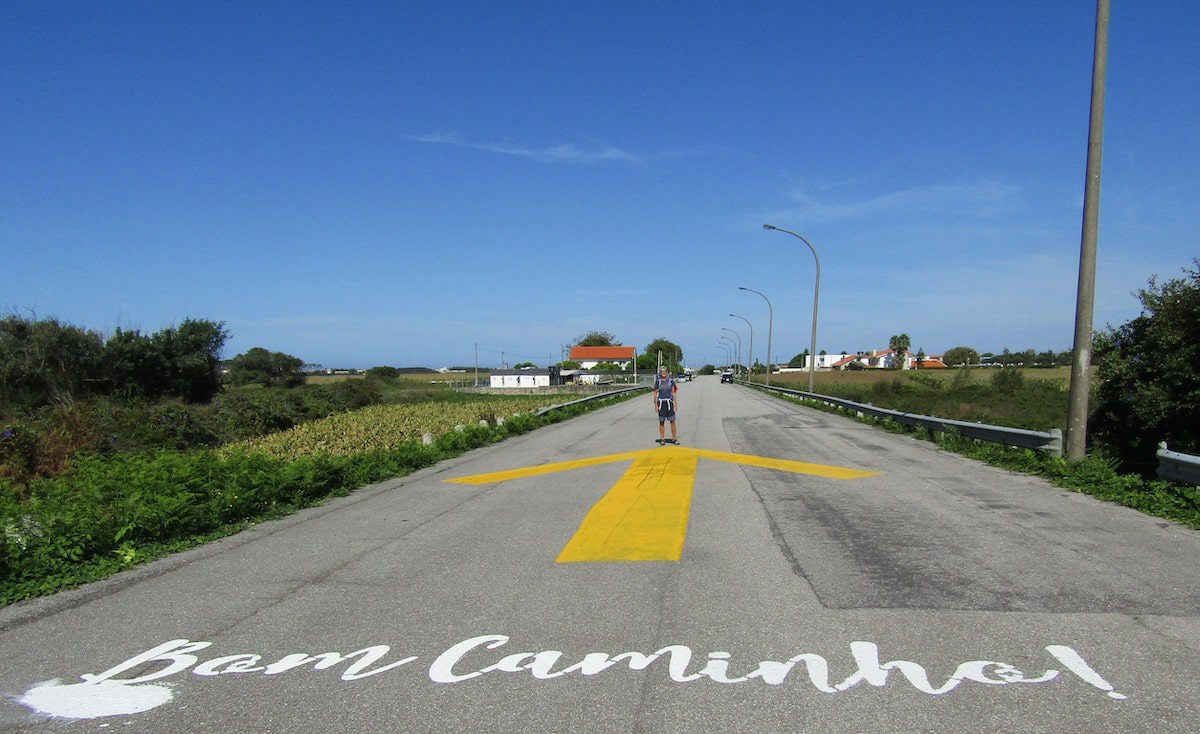






0 Comments
We always strive to use real photos from our own adventures, provided by the guest writer or from our personal travels. However, in some cases, due to photo quality, we must use stock photography. If you have any questions about the photography please let us know.
Disclaimer: We are so happy that you are checking out this page right now! We only recommend things that are suggested by our community, or through our own experience, that we believe will be helpful and practical for you. Some of our pages contain links, which means we’re part of an affiliate program for the product being mentioned. Should you decide to purchase a product using a link from on our site, JourneyWoman may earn a small commission from the retailer, which helps us maintain our beautiful website. JourneyWoman is an Amazon Associate and earns from qualifying purchases. Thank you!
We want to hear what you think about this article, and we welcome any updates or changes to improve it. You can comment below, or send an email to us at [email protected].